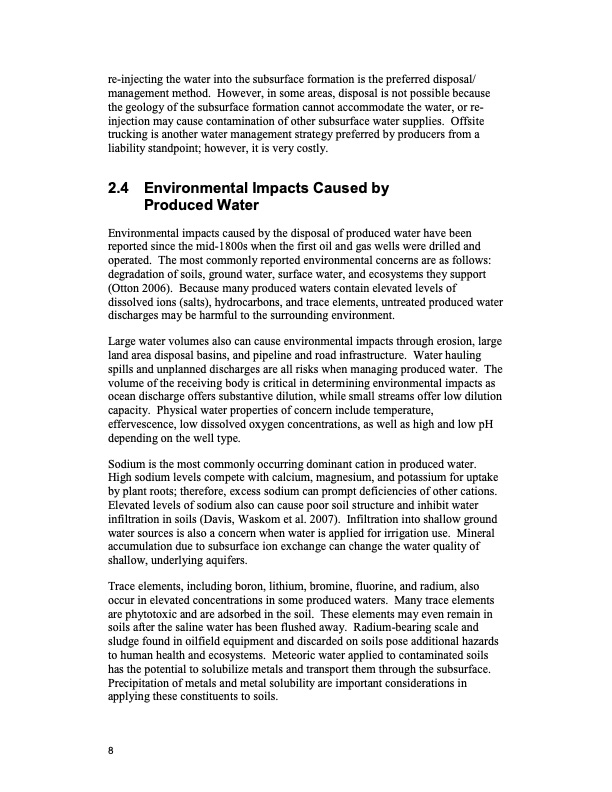
PDF Publication Title:
Text from PDF Page: 022
re-injecting the water into the subsurface formation is the preferred disposal/ management method. However, in some areas, disposal is not possible because the geology of the subsurface formation cannot accommodate the water, or re- injection may cause contamination of other subsurface water supplies. Offsite trucking is another water management strategy preferred by producers from a liability standpoint; however, it is very costly. 2.4 Environmental Impacts Caused by Produced Water Environmental impacts caused by the disposal of produced water have been reported since the mid-1800s when the first oil and gas wells were drilled and operated. The most commonly reported environmental concerns are as follows: degradation of soils, ground water, surface water, and ecosystems they support (Otton 2006). Because many produced waters contain elevated levels of dissolved ions (salts), hydrocarbons, and trace elements, untreated produced water discharges may be harmful to the surrounding environment. Large water volumes also can cause environmental impacts through erosion, large land area disposal basins, and pipeline and road infrastructure. Water hauling spills and unplanned discharges are all risks when managing produced water. The volume of the receiving body is critical in determining environmental impacts as ocean discharge offers substantive dilution, while small streams offer low dilution capacity. Physical water properties of concern include temperature, effervescence, low dissolved oxygen concentrations, as well as high and low pH depending on the well type. Sodium is the most commonly occurring dominant cation in produced water. High sodium levels compete with calcium, magnesium, and potassium for uptake by plant roots; therefore, excess sodium can prompt deficiencies of other cations. Elevated levels of sodium also can cause poor soil structure and inhibit water infiltration in soils (Davis, Waskom et al. 2007). Infiltration into shallow ground water sources is also a concern when water is applied for irrigation use. Mineral accumulation due to subsurface ion exchange can change the water quality of shallow, underlying aquifers. Trace elements, including boron, lithium, bromine, fluorine, and radium, also occur in elevated concentrations in some produced waters. Many trace elements are phytotoxic and are adsorbed in the soil. These elements may even remain in soils after the saline water has been flushed away. Radium-bearing scale and sludge found in oilfield equipment and discarded on soils pose additional hazards to human health and ecosystems. Meteoric water applied to contaminated soils has the potential to solubilize metals and transport them through the subsurface. Precipitation of metals and metal solubility are important considerations in applying these constituents to soils. 8PDF Image | Oil and Gas Produced Water Management

PDF Search Title:
Oil and Gas Produced Water ManagementOriginal File Name Searched:
report157.pdfDIY PDF Search: Google It | Yahoo | Bing
NFT (Non Fungible Token): Buy our tech, design, development or system NFT and become part of our tech NFT network... More Info
IT XR Project Redstone NFT Available for Sale: NFT for high tech turbine design with one part 3D printed counter-rotating energy turbine. Be part of the future with this NFT. Can be bought and sold but only one design NFT exists. Royalties go to the developer (Infinity) to keep enhancing design and applications... More Info
Infinity Turbine IT XR Project Redstone Design: NFT for sale... NFT for high tech turbine design with one part 3D printed counter-rotating energy turbine. Includes all rights to this turbine design, including license for Fluid Handling Block I and II for the turbine assembly and housing. The NFT includes the blueprints (cad/cam), revenue streams, and all future development of the IT XR Project Redstone... More Info
Infinity Turbine ROT Radial Outflow Turbine 24 Design and Worldwide Rights: NFT for sale... NFT for the ROT 24 energy turbine. Be part of the future with this NFT. This design can be bought and sold but only one design NFT exists. You may manufacture the unit, or get the revenues from its sale from Infinity Turbine. Royalties go to the developer (Infinity) to keep enhancing design and applications... More Info
Infinity Supercritical CO2 10 Liter Extractor Design and Worldwide Rights: The Infinity Supercritical 10L CO2 extractor is for botanical oil extraction, which is rich in terpenes and can produce shelf ready full spectrum oil. With over 5 years of development, this industry leader mature extractor machine has been sold since 2015 and is part of many profitable businesses. The process can also be used for electrowinning, e-waste recycling, and lithium battery recycling, gold mining electronic wastes, precious metals. CO2 can also be used in a reverse fuel cell with nafion to make a gas-to-liquids fuel, such as methanol, ethanol and butanol or ethylene. Supercritical CO2 has also been used for treating nafion to make it more effective catalyst. This NFT is for the purchase of worldwide rights which includes the design. More Info
NFT (Non Fungible Token): Buy our tech, design, development or system NFT and become part of our tech NFT network... More Info
Infinity Turbine Products: Special for this month, any plans are $10,000 for complete Cad/Cam blueprints. License is for one build. Try before you buy a production license. May pay by Bitcoin or other Crypto. Products Page... More Info
| CONTACT TEL: 608-238-6001 Email: greg@infinityturbine.com | RSS | AMP |